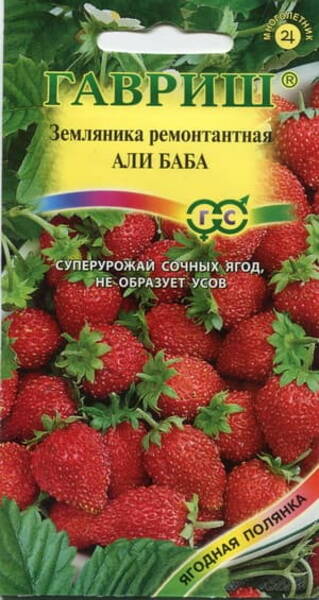Your shopping cart is empty!
Strawberry remontant "Ali Baba"
Remontant strawberry "Ali Baba" - Fragaria vesca.
A popular variety of remontant strawberries, valued for its unrivaled productivity. Does not form runners, quickly forms a powerful bush with a large number of inflorescences.
The berries are sweet, juicy, aromatic, medium-sized. It bears fruit from early summer until frost. The variety is distinguished by high winter hardiness, resistance to drought and many diseases and pests. It can be grown as a potted crop at home or on the balcony, then fruiting continues all year round.
Strawberries are sown in March-April. The seeds are mixed with sand and evenly distributed over a moistened, flat surface. Shoots appear within 30 days. In the phase of 1-2 true leaves, the seedlings are picked into pots. After 6 true leaves appear, they are planted in the ground with a distance of 25-30 cm between rows and 15-20 cm between plants. They prefer a sunny place and fertile, non-acidic soils.
Strawberry care comes down to loosening, watering, and fertilizing. The berries are picked repeatedly as they ripen.
A popular variety of remontant strawberries, valued for its unrivaled productivity. Does not form runners, quickly forms a powerful bush with a large number of inflorescences.
The berries are sweet, juicy, aromatic, medium-sized. It bears fruit from early summer until frost. The variety is distinguished by high winter hardiness, resistance to drought and many diseases and pests. It can be grown as a potted crop at home or on the balcony, then fruiting continues all year round.
Strawberries are sown in March-April. The seeds are mixed with sand and evenly distributed over a moistened, flat surface. Shoots appear within 30 days. In the phase of 1-2 true leaves, the seedlings are picked into pots. After 6 true leaves appear, they are planted in the ground with a distance of 25-30 cm between rows and 15-20 cm between plants. They prefer a sunny place and fertile, non-acidic soils.
Strawberry care comes down to loosening, watering, and fertilizing. The berries are picked repeatedly as they ripen.
* PRESERVING THE COLOR OF VEGETABLES AND FRUITS DURING CANNING.
A very simple technique is known for preserving the color of berries and fruits in preserves: you need to add ascorbic acid (vitamin C) to the preserve at a rate of 1.0 g of ascorbic acid per 1.0 kg of product. Ascorbic acid promotes the rapid displacement of air from vegetables and fruits, thereby preserving their natural color. The most beautiful jam of a natural color is obtained with the addition of ascorbic acid.











